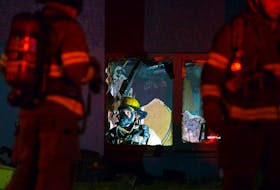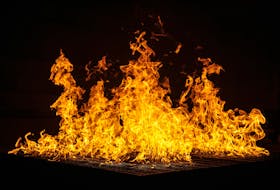A really big part of history is back with the Halifax Rifles (RCAC) in the 160th anniversary year of the regiment.
A Second World War era Sherman tank, named Hellfire, was shipped by crane and flatbed truck on Friday from CFB Shearwater, where it had been stored for years, to Windsor Park, the regiment's home while the Halifax Armoury building is being renovated.
John Boileau, Honorary Colonel of the regiment. Started in the Royal Canadian Dragoons but spent most of his career in Lord Strathcona's Horse (Royal Canadians).
The regiment, originally an infantry regiment that was converted to an armoured one during the Second World War, had been put on the supplementary order of battle in 1965, essentially disbanding it while maintaining its position for lineage purposes, Boileau said. It was reinstated in 2009.
“It'll be appropriate to have the memorial to all those who serve and who died in the Halifax Rifles there right outside where the regiment will be located,” Boileau said. “So it's kind of a big day in the regimental history, now that the regiment is back on the ground, to get this tank back here, get it restored and get it properly placed as a memorial again.”
Canada bought the tanks, which were built in the U.S. and intended to be shipped to the Soviet Union, when it became clear the war was ending. They were eventually replaced by the Centurian Mk. 3 for Regular Force units in 1953, and served as trainers for reserve armoured regiments until 1958.
The Halifax Rifles had four of them, named Havoc, Hunter, Hellion, and Hellfire.
Before they were moved to New Brunswick training centres, they were at Elkins Barracks in Hartlen Point.
“The tanks would go out to the end of Hartlen Point, fire their 76-mm main armament and 30-calibre machine guns at floating, empty oil drums in the water,” Boileau said.
Hellfire, a M4A2(76) Sherman weighing more than 30 tons and built with a 76-millimetre gun instead of the original model's 75, never saw combat action, but was dedicated as a memorial in 1968 by the Halifax Rifles Army Association and placed at the Halifax Common, before being moved to a concrete pad in front of the Armoury.
Over the years, it suffered from vandalism and people throwing garbage inside, as well as the effects of the weather and time.
The restoration project will involved scraping off worn paint and rust, fabricating replacement parts for those that are too deteriorated or were destroyed and giving it a new paint job to honour the regiment. Soldiers contributed money to the project to get it to this point and will volunteer their time and skills for the work.
Boileau said symbols of history and traditions are incredibly important to army units.
Lt.-Col. Todd Harris, commanding officer of the regiment said a lot of the young soldiers in the unit probably weren't aware of the tank's history.
“So, I'm looking forward to that, to having it here so now the troops will start to see and say 'Ok, so there was a life before the Rifles stood up again,” Harris said.
“It's cool to see where we've been and what we've done.”
This effort is the culmination of an idea Capt. Peter Patterson, a financial officer with the regiment, had. He's been working on it since February.
“I used to crawl on it as a kid,” Patterson said. “To me it was just a tank to crawl on, I never really knew anything about it, and even when I joined this regiment in 2013, I knew about Hellfire, but I didn't know it was ours.”
When he learned the history, he felt it was a shame to leave it to further deterioration.
Patterson said some of the money raised toward the budget of $6,000 came from ticket sales to a regimental ball that had to be cancelled due to COVID. When he asked the soldiers if they would be willing to donate the money instead of taking refunds, a majority said yes.
Moving it back to the Armoury won't happen until the building's renovations are complete, estimated to be five years, Patterson said.
“I was quite excited when I saw this thing hanging in the air. It's kind of like finding your lost toys as a child, and there it is, it's broken, it's damaged, and you know you're going to have a chance to bring it into an area of safety and get it fixed up and looking good.”
Patterson said he discovered that the men of the Halifax Rifles were distributed to other units during the Second World War and he found a photo of one man who had still served under the regiment's cap badge. Trooper William Burton Croft was killed Aug. 14, 1944, at the age of 24. Patterson hopes Hellfire can be painted the same pattern as the armoured unit Croft served and died with.








